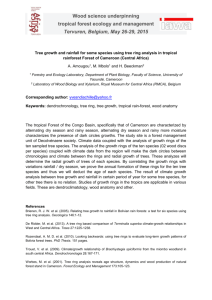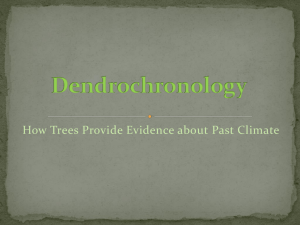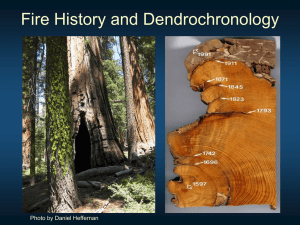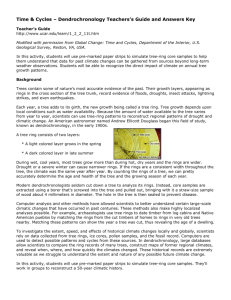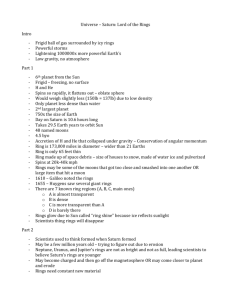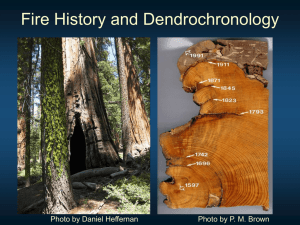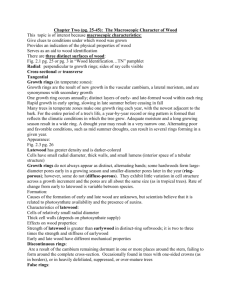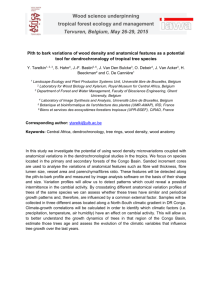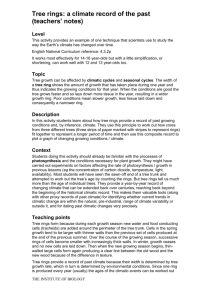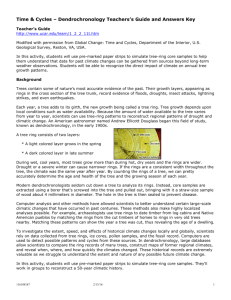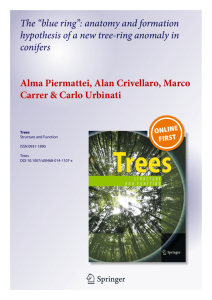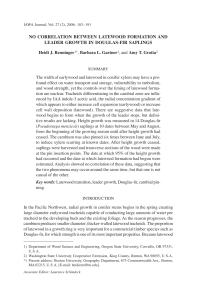Tree Ring sample.
advertisement
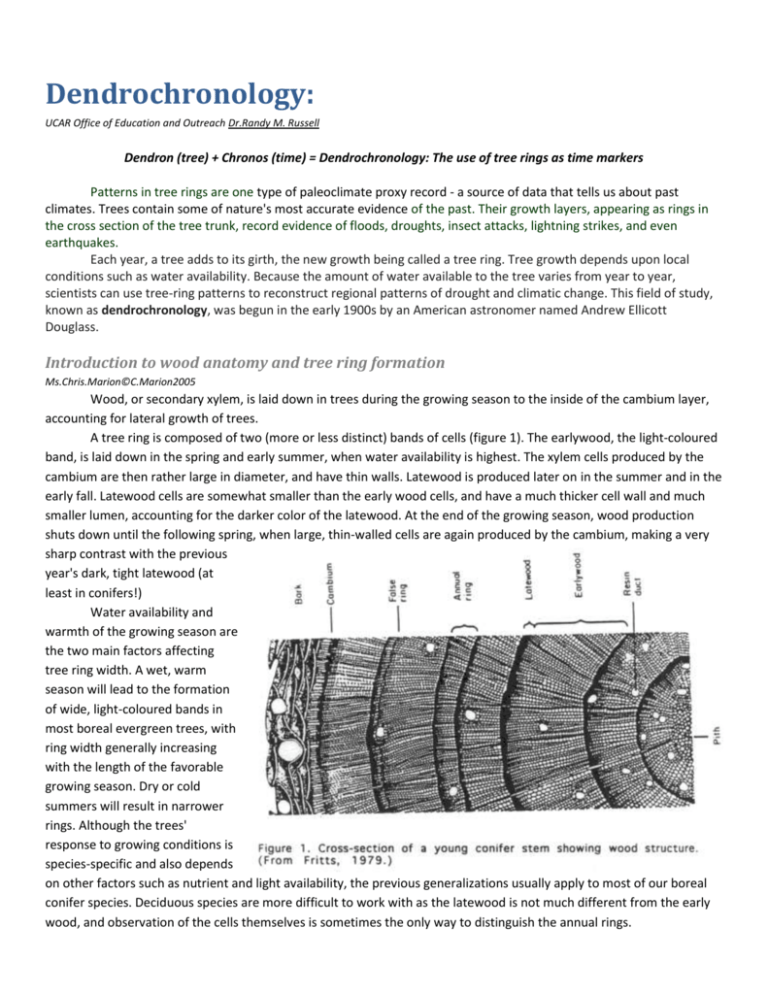
Dendrochronology: UCAR Office of Education and Outreach Dr.Randy M. Russell Dendron (tree) + Chronos (time) = Dendrochronology: The use of tree rings as time markers Patterns in tree rings are one type of paleoclimate proxy record - a source of data that tells us about past climates. Trees contain some of nature's most accurate evidence of the past. Their growth layers, appearing as rings in the cross section of the tree trunk, record evidence of floods, droughts, insect attacks, lightning strikes, and even earthquakes. Each year, a tree adds to its girth, the new growth being called a tree ring. Tree growth depends upon local conditions such as water availability. Because the amount of water available to the tree varies from year to year, scientists can use tree-ring patterns to reconstruct regional patterns of drought and climatic change. This field of study, known as dendrochronology, was begun in the early 1900s by an American astronomer named Andrew Ellicott Douglass. Introduction to wood anatomy and tree ring formation Ms.Chris.Marion©C.Marion2005 Wood, or secondary xylem, is laid down in trees during the growing season to the inside of the cambium layer, accounting for lateral growth of trees. A tree ring is composed of two (more or less distinct) bands of cells (figure 1). The earlywood, the light-coloured band, is laid down in the spring and early summer, when water availability is highest. The xylem cells produced by the cambium are then rather large in diameter, and have thin walls. Latewood is produced later on in the summer and in the early fall. Latewood cells are somewhat smaller than the early wood cells, and have a much thicker cell wall and much smaller lumen, accounting for the darker color of the latewood. At the end of the growing season, wood production shuts down until the following spring, when large, thin-walled cells are again produced by the cambium, making a very sharp contrast with the previous year's dark, tight latewood (at least in conifers!) Water availability and warmth of the growing season are the two main factors affecting tree ring width. A wet, warm season will lead to the formation of wide, light-coloured bands in most boreal evergreen trees, with ring width generally increasing with the length of the favorable growing season. Dry or cold summers will result in narrower rings. Although the trees' response to growing conditions is species-specific and also depends on other factors such as nutrient and light availability, the previous generalizations usually apply to most of our boreal conifer species. Deciduous species are more difficult to work with as the latewood is not much different from the early wood, and observation of the cells themselves is sometimes the only way to distinguish the annual rings. Many events will happen in the life of a tree which may be recorded in its wood either at the cellular level or as more obvious scars or deformations in the tree itself. Frost, insect epidemics, and droughts are a few examples of events that will be recorded in the rings at the precise year (or series of years) at which they occurred. Fire and other cambiumdestroying accidents will stop the production of wood where the cambium was damaged, leaving a scar that might eventually close with time; this scar can also be dated. Cutting down a tree will stop lateral growth altogether and tell us the year the tree was felled. Tree death by flooding, burying, or uprooting can also be dated. A tree ring consists of two layers: A light colored layer which grows in the spring A dark colored layer which forms in late summer During wet, cool years, most trees grow more than during hot, dry years and the rings are wider. Drought or a severe winter can cause narrower rings. If the rings are a consistent width throughout the tree, the climate was the same year after year. By counting the rings of a tree, we can pretty accurately determine the age and health of the tree and the growing season of each year. Modern dendrochronologists seldom cut down a tree to analyze its rings. Instead, core samples are extracted using a borer that's screwed into the tree and pulled out, bringing with it a straw-size sample of wood about 4 millimeters in diameter. The hole in the tree is then sealed to prevent disease. Tree Ring sample. Computer analysis and other methods have allowed scientists to Credit: NCAR better understand certain large-scale climatic changes that have occurred in past centuries. These methods also make highly localized analyses possible. For example, archaeologists use tree rings to date timber from log cabins and Native American pueblos by matching the rings from the cut timbers of homes to rings in very old trees nearby. Matching these patterns can show the year a tree was cut, thus revealing the age of a dwelling. Photo: Laboratory of Tree-Ring Research, The University of Arizona Tree ring data is only collected outside of the tropics. Trees in temperate latitudes have annual spurts of growth in the summer and periods of dormancy in the winter, which creates the distinctive pattern of light and dark bands. Tropical trees grow year-round, and thus do not have the alternating dark and light band pattern that allows us to read tree ring records. Tree ring records can be combined to create climate records that span a timeframe longer than the life of a single tree. For example, the data from a living, 200-year old tree could be combined with a data from wood from a tree that was felled 150 years ago (after living a couple of centuries) to produce a composite dataset spanning several hundred years. Trees, alive or dead, are not the only source of wood used by dendrochronologists to construct such extended records. Beams from old buildings or ruins, samples from wooden frames of old paintings, and slivers from violins have all been used to add wood samples from trees long dead to climate chronologies. In some cases, tree rings enshrined in petrified wood even give us some insights into climate conditions in truly ancient times. Data Set: Questions: 1. You will need to generate graphs: ***Be sure to include a trend line and r2 value for each variable*** 2. Describe what you see? Decipher the trends and record observations. 3. What conclusions can be made about the climate through tree ring growth and temperature? (hint: think temperature and precipitation). Use 3 pieces of evidences from your research to support your ideas. 4. How can present day data such as this be use by paleoclimatologists to reconstruct past climates? 5. What are the limitations of this source of information? Resources: http://www.windows2universe.org/earth/climate/dendrochronology_build_tree.html http://www.ucar.edu/learn/1_2_2_11t.htm http://www.ncdc.noaa.gov/paleo/treering.html http://www.windows2universe.org/earth/climate/treering_cores_align.html
